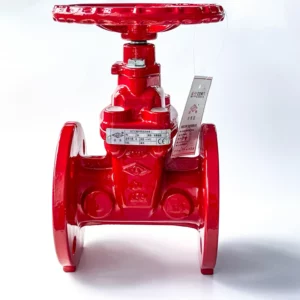Ductile iron gate valves, like any other industrial valves, should meet certain industry standards and certifications to ensure their quality, safety, and compliance with regulations.
Some of the common standards and certifications that ductile iron gate valves should adhere to include:
- American Water Works Association (AWWA) Standards: The AWWA sets standards for water-related products and services. Ductile iron gate valves used in water distribution systems should conform to AWWA standards, such as AWWA C509 for resilient-seated gate valves and AWWA C515 for metal-seated gate valves.
- American National Standards Institute (ANSI) Standards: ANSI standards are widely recognized in the United States. Ductile iron gate valves may need to meet specific ANSI standards, such as ANSI B16.34 for valve design, and ANSI B16.10 for face-to-face dimensions.
- International Organization for Standardization (ISO) Standards: ISO standards are used worldwide, and some ductile iron gate valves may conform to ISO standards, such as ISO 7259 for face-to-face dimensions and ISO 5208 for pressure testing of valves.
- Underwriters Laboratories (UL) Certification: UL is a safety certification organization. Gate valves that are used in fire protection systems often require UL certification to ensure they meet specific safety and performance standards.
- National Sanitation Foundation (NSF) Certification: NSF certification is important for ductile iron gate valves used in potable water systems. NSF/ANSI 61 certification ensures that materials in contact with drinking water do not leach harmful contaminants.
- European Conformity (CE) Marking: If ductile iron gate valves are intended for sale in the European Union, they may need to carry the CE marking, indicating compliance with EU safety and environmental requirements.
- American Petroleum Institute (API) Standards: For ductile iron gate valves used in the oil and gas industry, they may need to meet API standards, such as API 600 for steel gate valves, which could apply to gate valves with ductile iron components.
- Quality Management System (QMS) Certification: Manufacturers of ductile iron gate valves should have a QMS certification, such as ISO 9001, to ensure consistent quality in their products and processes.
- Product-specific Standards: In addition to general industry standards, there may be product-specific standards that apply to particular types of ductile iron gate valves, such as those used in cryogenic applications, high-pressure systems, or corrosive environments.
- Local and National Regulations: Compliance with local and national regulations, including building codes and safety standards, is essential to ensure that ductile iron gate valves are used safely and legally in specific applications.
It’s important for purchasers and users of ductile iron gate valves to verify that the valves meet the relevant standards and certifications required for their specific applications to ensure product quality, safety, and regulatory compliance.
What are the common sizes and pressure ratings available for ductile iron gate valves in the market?
Ductile iron gate valves are available in a range of sizes and pressure ratings to accommodate various applications and industries.
The common sizes and pressure ratings available in the market include:
Sizes:
- Small Sizes: Ductile iron gate valves are available in smaller sizes, typically ranging from 2 inches (50 mm) to 12 inches (300 mm) for residential and light industrial applications. These smaller sizes are often used in water supply systems, Ductile iron gate valve HVAC, and irrigation.
- Intermediate Sizes: Intermediate-sized ductile iron gate valves can range from 14 inches (350 mm) to 24 inches (600 mm). They are commonly used in municipal water and wastewater systems, as well as in industrial processes.
- Large Sizes: For industrial and heavy-duty applications, ductile iron gate valves are available in larger sizes, exceeding 24 inches (600 mm). These larger sizes are used in industries like power generation, petrochemical, and mining.
Pressure Ratings:
- Low Pressure (Class 125/150): Ductile iron gate valves with low-pressure ratings, such as Class 125 or Class 150, are suitable for applications with lower pressure requirements, typically up to 150 psi (10.3 bar). These are often used in residential and light industrial settings.
- Intermediate Pressure (Class 250/300): Intermediate-pressure ductile iron gate valves, rated as Class 250 or Class 300, are used for applications with moderately higher pressure needs, ranging from 250 psi (17.2 bar) to 300 psi (20.7 bar). These are common in municipal water distribution systems and industrial processes.
- High Pressure (Class 600/900+): Ductile iron gate valves with high-pressure ratings, such as Class 600 or Class 900, are designed for demanding applications with significantly higher pressures, ranging from 600 psi (41.4 bar) and exceeding 900 psi (62.1 bar). These valves are used in heavy industrial processes, power plants, and critical pipelines.
It’s important to note that these size and pressure rating ranges are not exhaustive, and manufacturers may offer ductile iron gate valves with specific sizes and pressure ratings tailored to meet the requirements of various applications. When selecting a ductile iron gate valve, it’s essential to consider the specific needs of the application, including the fluid type, pressure, temperature, and flow characteristics, to choose the most suitable valve for the task.

